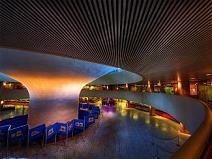High-tech architecture
High-tech is one of the styles in architecture, which refers to the broadly defined postmodernism. In contrast to modernism here the object itself is important, not the object as a functional use of space. The object is the aim. The structure of the buildings in the style of high-tech are exposed, treated as an ornament at the same time. At this point, this architecture is close to postmodernism.
At the beginning of the twentieth century, modern building techniques and new materials (glass, steel, concrete) have been appreciated by contemporary modernist architects. As technology has greatly evolved, new materials and modern equipment started to be used in the construction industry. Thus was born a new architectural design developed using advanced technology, known as high-tech.

High-tech style is characterized by countless use of new technologies in the construction of the buildings and their technical equipment. Technical elements, such as blinds or solar cells, are a kind of modern ornament, especially when put together in repetitive sequence.
High-tech architecture wants to integrate the technical equipment of the building in its structure. This strengthens the impact of the object in a high-tech style, both in terms of functional and visual matter. So arises the so-called intelligent building, in which installations and construction are designed as an integral whole.
The most famous architectural high-tech works are: town hall in London, standing next to Tower Bridge, London's Millennium Dome and Wembley Stadium, office building Lloyd's in London Olympic Stadium and the Allianz Arena in Munich, the Eiffel Tower and the Centre Georges Pompidou in Paris, HSBC headquarter in Hong Kong, Zizkov Television Tower in Prague, Hotel Arts Skidmore and the Torre Agbar in Barcelona, the National Centre for the Performing Arts in Beijing, Hearst Tower in New York, the Beetham Tower in Manchester, John Hancock Center in Chicago, Mode Gakuen Cocoon Tower in Tokyo.
Representatives of high-tech architecture are: Norman Foster, Renzo Piano, Richard Rogers, Michael Hopkins, Nicholas Grimshaw, Schweger & Partner, Jean Nouvel, Paul Andreu, Michel Virlogeux.